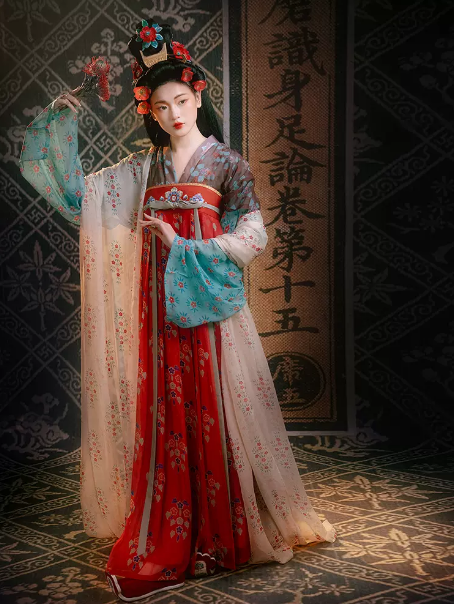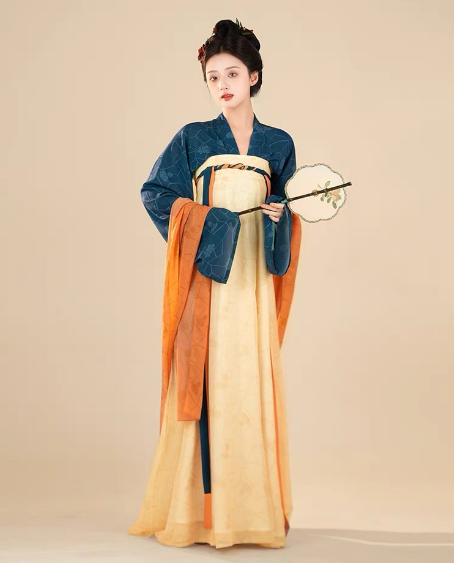Historical Context
Origins in the Tang Dynasty
The Tang Dynasty, spanning from 618 to 907 AD, witnessed the birth of chest-length skirts, or “Qun” (裙), as an essential part of women’s attire. Tailors of the era, working in vibrant cities like Chang’an, now known as Xi’an, innovated these garments as fashion statements reflecting the dynasty’s prosperity. These skirts often featured in court life, with noblewomen showcasing luxurious versions made from silk.
The introduction of chest-length skirts marked a departure from previous styles that were more conservative and less form-fitting. This new silhouette allowed for greater movement and displayed the dynasty’s openness to cultural influences from along the Silk Road.

Evolution of Styles through the Tang Period
As the Tang Dynasty progressed, so did the styles of the chest-length skirts. These changes mirrored the dynamic nature of the Tang society, often influenced by trade with Central Asia. Skirts transitioned from straight, narrow shapes to wider, more elaborate forms, often seen in the painted figures of the Dunhuang caves.
The complexity of the skirts grew, with pleats and layered designs becoming popular among the fashionable elite. This evolution can also be traced through surviving Tang Dynasty statutes, where different styles and layers of Qun are finely depicted, signaling the wearer’s status and wealth. The grandeur of these skirts reached its zenith during the reign of Emperor Xuanzong, where Tang court fashion peaked in both opulence and diversity.
By examining the fabric quality and intricate patterns of excavated textiles, historians can deduce the high level of craftsmanship and attention to detail that Tang artisans dedicated to these garments. This sartorial elegance stands as a testament to the Tang Dynasty’s affluence and its pivotal role in the history of Chinese fashion.
Design Specifics
Defining Features of Chest-Length Skirts
Chest-length skirts of the Tang Dynasty showcased distinct design elements, setting them apart from earlier and later fashion trends. These characteristics included:
- Form-fitting Silhouette: Tailors tailored these skirts to snugly fit the upper body, emphasizing the wearer’s curves and allowing for unrestricted movement.
- High Waistline: Positioned just below the chest, the high waistline, from which the name “chest-length skirts” derives, not only defined the appearance but also ensured comfort.
- Wrap-around Closure: Most chest-length skirts featured a wrap-around closure, which wearers could securely fasten using ties or buttons, making wearing and removal effortless.
- Ornate Fastenings: Elaborate fastenings at the chest and shoulders added an extra layer of elegance to the garment.
- Pleated Elegance: Many of these skirts featured intricate pleats, enhancing their visual appeal and lending graceful fluidity to the fabric.
- Luxurious Fabrics: Skilled artisans crafted these skirts from opulent materials such as silk, brocade, and satin, serving as exquisite displays of the wearer’s social status and affluence.
Variations Across Different Regions
The design of chest-length skirts varied across the diverse regions of the Tang Dynasty, each reflecting unique influences and preferences. Here’s a closer look at these regional distinctions:
- Northern China: In the north, practicality took precedence, with skirts designed to facilitate ease of movement. They commonly utilized durable materials suitable for coping with colder climates.
- Southern China: In the milder south, skirts leaned towards lighter fabrics and intricate embroidery. They gained renown for their vibrant colors and floral motifs.
- Central Asia: Central Asian designs incorporated exotic elements from the Silk Road, introducing unique textiles, metallic threads, and nomadic-inspired patterns.
- Courtly Elegance: Within the Tang court, skirt designs reached the pinnacle of opulence and complexity. These garments featured rich, multi-layered aesthetics, often embellished with precious gems and intricate embroidery.
- Everyday vs. Formal Attire: Distinctions were apparent in skirt designs for everyday wear versus formal occasions. People preferred daily wear skirts for their simplicity and functionality, while they embellished those reserved for special events extravagantly.
These regional differences highlighted the Tang Dynasty’s cultural diversity and underscored the role of clothing as a vivid expression of identity and social status.
Cultural Significance
Social Status and the Skirt
Chest-length skirts in the Tang Dynasty, reflecting one’s social status, held paramount importance:
- Class Distinctions: These skirts clearly delineated social hierarchies. The aristocracy adorned themselves in silk, showcasing their elite status.
- Imperial Court: Within the court, officials and concubines flaunted opulent skirts, signifying proximity to power.
- Regulation through Laws: Sumptuary laws regulated fabrics and ornamentation based on social class, preserving societal order.
- Marriage and Dowries: A woman’s skirt quality influenced her dowry and marriage prospects.
Symbolism and Cultural Meanings
Chest-length skirts carried profound symbolism and cultural significance:
- Fertility and Prosperity: A snug silhouette symbolized fertility, promising prosperity.
- Fashion as Identity: Clothing served as self-expression, conveying identity through fabric, color, and adornments.
- Dynastic Influence: Skirts symbolized the dynasty’s openness to external influences and cosmopolitan nature.
- Artistic Inspiration: Tang art and literature depicted characters in these skirts, conveying roles and personalities.
Chest-length skirts embodied the essence of Tang Dynasty culture, reflecting both individual aspirations and collective values.
Manufacturing Techniques
Skillful Artisanship
Chest-length skirts of the Tang Dynasty were crafted with precision and expertise:
- Handcrafted Excellence: Skilled artisans meticulously tailored each skirt, ensuring a perfect fit.
- Intricate Details: Embroidery, pleating, and decorative elements demanded meticulous attention.
- Quality Control: Stringent quality checks maintained high standards.
- Customization: Tailors often customized skirts to individual preferences.
Materials Used in the Tang Dynasty
Luxurious Fabric Choices
The materials for Tang Dynasty chest-length skirts were carefully selected:
- Silk Dominance: Silk was the predominant fabric due to its luxurious feel and cultural significance.
- Brocade Varieties: Brocade, known for its rich patterns, was also favored.
- Satin Elegance: Satin, with its smooth texture, was a popular choice for formal occasions.
- Gemstone Embellishments: Some skirts featured gemstone adornments, adding to their opulence.
Sewing and Assembly Methods
Precision in Construction
The assembly of these skirts involved meticulous techniques:
- Hand-Stitched Seams: Skilled seamstresses hand-stitched seams for durability.
- Intricate Embroidery: Fine embroidery was added using delicate handwork.
- Layering Mastery: Multi-layered designs demanded precise assembly.
- Fastening Expertise: Elaborate fastenings were securely attached to the garment.
These manufacturing techniques resulted in exquisite chest-length skirts that exemplified the Tang Dynasty’s craftsmanship and dedication to sartorial excellence.
Preservation and Study
Ensuring Skirt Preservation

Preserving chest-length skirts from the Tang Dynasty requires dedicated efforts:
- Textile Conservation: Experts employ techniques to prevent fabric deterioration.
- Climate-Controlled Storage: Museums maintain stable humidity and temperature.
- Protective Encasement: Skirts are stored in acid-free containers to prevent damage.
- Regular Inspection: Routine checks identify signs of wear or degradation.
Archaeological Finds and Research
Archaeological discoveries provide valuable insights into Tang Dynasty skirts:
- Dunhuang Cave Finds: Dunhuang’s caves revealed well-preserved textiles from the era.
- Excavation Sites: Skirts have been unearthed at archaeological sites like Xi’an.
- Research Techniques: Advanced methods, such as radiocarbon dating, date artifacts.
- Material Analysis: Scientists analyze fabric composition for historical context.
Display in Museums and Collections
Museums showcase chest-length skirts, offering educational and cultural value:
- Public Exhibition: Skirts are displayed for the public’s benefit.
- Educational Programs: Museums offer programs and lectures on Tang Dynasty fashion.
- Historical Context: Exhibits provide insights into clothing’s historical context.
- Curatorial Care: Museums invest in artifact care and presentation methods.
Chest-length skirts’ preservation, archaeological finds, and museum displays contribute to our understanding of Tang Dynasty fashion, offering a glimpse into ancient Chinese culture and craftsmanship.







